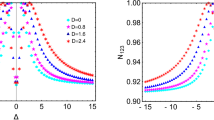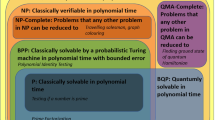Abstract
The interplay of quantum information theory and condensed matter physics has generated fruitful results, which promote our understanding of quantum phase transition. Magic, as a crucial resource in fault-tolerant quantum computation, may provide new insights into quantum phase transition. Based on quantum renormalization group method, we investigate the role magic plays in detecting quantum phase transition in the one-dimensional anisotropic XXZ model and XY model. The quantifier of magic we employed is defined via the characteristic functions of quantum states; it not only has nice properties, but also can be straightforwardly calculated. As the iteration steps of quantum renormalization group increase in the spin models, the magic quantifier achieves its maximum, while the first-order derivative of the magic is discontinuous around the critical points, which are signatures of quantum phase transition. The scaling behavior of the renormalized magic in terms of the system size is demonstrated, and a comparative study with coherence is made.






Similar content being viewed by others
Data availability statement
All data generated or analyzed during this study are included in this published article.
References
Sachdev, S.: Quantum Phase Transitions. Cambridge University Press (2011)
Sondhi, S.L., Girvin, S., Carini, J., Shahar, D.: Continuous quantum phase transitions. Rev. Mod. Phys. 69(1), 315 (1997)
Osterloh, A., Amico, L., Falci, G., Fazio, R.: Scaling of entanglement close to a quantum phase transition. Nature 416(6881), 608–610 (2002)
Osborne, T.J., Nielsen, M.A.: Entanglement in a simple quantum phase transition. Phys. Rev. A 66(3), 032110 (2002)
Vidal, G., Latorre, J.I., Rico, E., Kitaev, A.: Entanglement in quantum critical phenomena. Phys. Rev. Lett. 90(22), 227902 (2003)
Vidal, J., Palacios, G., Mosseri, R.: Entanglement in a second-order quantum phase transition. Phys. Rev. A 69(2), 022107 (2004)
Gu, S.-J., Lin, H.-Q., Li, Y.-Q.: Entanglement, quantum phase transition, and scaling in the XXZ chain. Phys. Rev. A 68(4), 042330 (2003)
Gu, S.-J., Tian, G.-S., Lin, H.-Q.: Ground-state entanglement in the XXZ model. Phys. Rev. A 71(5), 052322 (2005)
Kargarian, M., Jafari, R., Langari, A.: Dzyaloshinskii-Moriya interaction and anisotropy effects on the entanglement of the Heisenberg model. Phys. Rev. A 79(4), 042319 (2009)
Kargarian, M., Jafari, R., Langari, A.: Renormalization of entanglement in the anisotropic Heisenberg (XXZ) model. Phys. Rev. A 77(3), 032346 (2008)
Ma, F.-W., Liu, S.-X., Kong, X.-M.: Entanglement and quantum phase transition in the one-dimensional anisotropic XY model. Phys. Rev. A 83(6), 062309 (2011)
Song, X.-K., Wu, T., Ye, L.: Negativity and quantum phase transition in the anisotropic XXZ model. Eur. Phys. J. D 67(5), 1–4 (2013)
Karpat, G., Çakmak, B., Fanchini, F.: Quantum coherence and uncertainty in the anisotropic XY chain. Phys. Rev. B 90(10), 104431 (2014)
Hu, M.-L., Gao, Y.-Y., Fan, H.: Steered quantum coherence as a signature of quantum phase transitions in spin chains. Phys. Rev. A 101(3), 032305 (2020)
Qin, M., Ren, Z., Zhang, X.: Dynamics of quantum coherence and quantum phase transitions in XY spin systems. Phys. Rev. A 98(1), 012303 (2018)
Wu, W., Xu, J.-B.: Quantum renormalization group approach to quantum coherence and multipartite entanglement in an XXZ spin chain. Phys. Lett. A 381(4), 239–244 (2017)
Qiu, L., Tang, G., Yang, X.-Q., Wang, A.-M.: Relating tripartite quantum discord with multisite entanglement and their performance in the one-dimensional anisotropic XXZ model. EPL Europhys. Lett. 105(3), 30005 (2014)
Dillenschneider, R.: Quantum discord and quantum phase transition in spin chains. Phys. Rev. B 78(22), 224413 (2008)
Yao, Y., Li, H.-W., Zhang, C.-M., Yin, Z.-Q., Chen, W., Guo, G.-C., Han, Z.-F.: Performance of various correlation measures in quantum phase transitions using the quantum renormalization-group method. Phys. Rev. A 86(4), 042102 (2012)
Zanardi, P., Paunković, N.: Ground state overlap and quantum phase transitions. Phys. Rev. E 74(3), 031123 (2006)
Dai, H., Fu, S., Luo, S.: Spin nonclassicality and quantum phase transition in the XY spin model. Phys. Scr. 95(10), 105107 (2020)
Gottesman, D.: The heisenberg representation of quantum computers. arXiv preprint arXiv:quant-ph/9807006 (1998)
Veitch, V., Mousavian, S.H., Gottesman, D., Emerson, J.: The resource theory of stabilizer quantum computation. New J. Phys. 16(1), 013009 (2014)
Howard, M., Campbell, E.: Application of a resource theory for magic states to fault-tolerant quantum computing. Phys. Rev. Lett. 118(9), 090501 (2017)
Wilson, K.G.: Renormalization group and critical phenomena. i. renormalization group and the kadanoff scaling picture. Phys. Rev. B 4(9), 3174 (1971)
Wilson, K.G.: Renormalization group and critical phenomena. ii. phase-space cell analysis of critical behavior. Phys. Rev. B 4(9), 3184 (1971)
Wilson, K.G.: The renormalization group: critical phenomena and the kondo problem. Rev. Mod. Phys. 47(4), 773 (1975)
Dai, H., Fu, S., Luo, S.: Detecting magic states via characteristic functions. Int. J. Theor. Phys. 61(2), 1–18 (2022)
Knill, E.: Fault-tolerant postselected quantum computation: Schemes. arXiv preprint arXiv:quant-ph/0402171 (2004)
Heinrich, M., Gross, D.: Robustness of magic and symmetries of the stabiliser polytope. Quantum 3, 132 (2019)
Bravyi, S., Smith, G., Smolin, J.A.: Trading classical and quantum computational resources. Phys. Rev. X 6(2), 021043 (2016)
Bravyi, S., Gosset, D.: Improved classical simulation of quantum circuits dominated by clifford gates. Phys. Rev. Lett. 116(25), 250501 (2016)
Bravyi, S., Browne, D., Calpin, P., Campbell, E., Gosset, D., Howard, M.: Simulation of quantum circuits by low-rank stabilizer decompositions. Quantum 3, 181 (2019)
Wang, X., Wilde, M.M., Su, Y.: Efficiently computable bounds for magic state distillation. Phys. Rev. Lett. 124(9), 090505 (2020)
Liu, Z.-W., Winter, A.: Many-body quantum magic. PRX. Quantum 3(2), 020333 (2022)
Regula, B.: Probabilistic transformations of quantum resources. Phys. Rev. Lett. 128(11), 110505 (2022)
Leone, L., Oliviero, S.F., Hamma, A.: Stabilizer Rényi entropy. Phys. Rev. Lett. 128(5), 050402 (2022)
Martin-Delgado, M.A., Sierra, G.: Analytic formulations of the density matrix renormalization group. Int. J. Mod. Phys. A 11(17), 3145–3174 (1996)
Baumgratz, T., Cramer, M., Plenio, M.B.: Quantifying coherence. Phys. Rev. Lett. 113(14), 140401 (2014)
Martin-Delgado, M.A., Sierra, G.: Real space renormalization group methods and quantum groups. Phys. Rev. Lett. 76(7), 1146 (1996)
Acknowledgements
This work was supported by the Fundamental Research Funds for the Central Universities, Grant No. FRF-TP-19-012A3.
Author information
Authors and Affiliations
Corresponding author
Ethics declarations
Conflict of interest
On behalf of all authors, the corresponding author states that there is no conflict of interest.
Additional information
Publisher's Note
Springer Nature remains neutral with regard to jurisdictional claims in published maps and institutional affiliations.
Appendices
Appendix A: Renormalization of XXZ spin model under QRG method
The Hamiltonian of the one-dimensional anisotropic XXZ model on a periodic chain of N sites is [10]
where \(J,\Delta > 0\), J is the exchange constant, \(\Delta \) is the anisotropy parameter, and \(\sigma ^{\alpha }_{k}(\alpha =x,y,z)\) denotes Pauli matrices at site k. The spin chain is divided into three-site blocks [40] (by the Kadanoff’s block approach given in Fig. 7) to get a self-similar Hamiltonian
where \(\sigma ^{\alpha }_{l,j}\) refers to the corresponding Pauli matrix \(\alpha \) (\(\alpha =x,y,z\)) at site j (j=1,2,3) of the l-th block.
The intra-block \(H^I\) and the inter-block \(H^{II}\) Hamiltonian are
respectively.
Using Kadanoff’s block approach, the Hamiltonian of the system in one-dimensional XXZ chain is divided into intra-block Hamiltonian \(H^I\) and inter-block Hamiltonian \(H^{II}\). In this way, an effective Hamiltonian \(H^\mathrm{{eff}}\) can be obtained by projecting the Hamiltonian H onto the renormalized space
The two degenerate ground states are
where \(q=-\frac{1}{2}(\Delta +\sqrt{\Delta ^{2}+8})\), \(|\uparrow \rangle \) and \(|\downarrow \rangle \) are the eigenstates of \(\sigma ^{z}\).
The projection operator \(P_{0}\) is expressed as
where \(P^l_0 \) is the projection operator \(P_{0}\) for the l-th block, which is defined as
with \(|\Uparrow \rangle _l\) and \(|\Downarrow \rangle _l\) being the renamed states of each block to represent the effective site degrees of freedom. The renormalization of Pauli matrices can be calculated as
with
where the indices 1,2,3 refer to the first, second and third site of each block.
The effective Hamiltonian \(H^\mathrm{{eff}}\) can be written as
from which we obtain
with
Appendix B: Calculation of the magic \(M(\rho )\) on the ground state in XXZ model
The density matrix of the ground state in XXZ model is expressed as
The magic in the three-site block can be written as
where \(k_j=0,x,y,z (j=1,2,3)\). Substituting the quantum state in Eq. (B1) into Eq. (B2), we can straightforwardly calculate the trace of the product between \(\rho \) and each of the 64 combinations \(\sigma ^{k_1}\otimes \sigma ^{k_2}\otimes \sigma ^{k_3}\), respectively. For example,
Similarly, another combination \(|\textrm{tr} (\rho \sigma ^{z}\otimes \sigma ^{z}\otimes \sigma ^{z})|\) has the same result 1. By analogous method, we can calculate all 64 traces; adding these values together, we get the value of the magic as
Appendix C: Renormalization of XY spin model under QRG method
The Hamiltonian of the XY model on a periodic chain with N sites reads [11]
where \(J>0\) and \(-1<\gamma <1\), J is the exchange coupling constant, \(\gamma \) is the anisotropy parameter, and \(\sigma ^{\alpha }_{k}\) are Pauli matrices at site k. After one renormalization, the Hamiltonian H is divided into the intra-block \(H^I\) and the inter-block \(H^{II}\) Hamiltonian as
where \(\sigma ^{\alpha }_{l,j}\) refers to the \(\alpha \) (\(\alpha =x,y,z\)) of the Pauli matrix at site j (j=1,2,3) of the l-th block Hamiltonian.
The two degenerate ground states of XY Hamiltonian are
The projection operator \(T_{0}\) can be expressed as
where \(|\Uparrow \rangle _l\) and \(|\Downarrow \rangle _l\) are renamed states of each block to represent the effective site degrees of freedom.
The renormalization of Pauli matrices is defined by
where
The effective Hamiltonian of the renormalized chain can be expressed as
where the parameters are
Rights and permissions
Springer Nature or its licensor (e.g. a society or other partner) holds exclusive rights to this article under a publishing agreement with the author(s) or other rightsholder(s); author self-archiving of the accepted manuscript version of this article is solely governed by the terms of such publishing agreement and applicable law.
About this article
Cite this article
He, J., Fu, S. Renormalization of magic and quantum phase transition in spin models. Quantum Inf Process 22, 161 (2023). https://doi.org/10.1007/s11128-023-03905-6
Received:
Accepted:
Published:
DOI: https://doi.org/10.1007/s11128-023-03905-6





